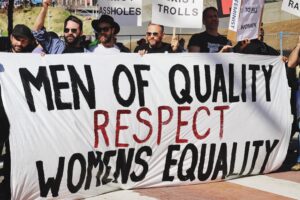
The Current State of Domestic Violence Services, Part 3
In the first two parts of this post, I wrote about trends that I’ve observed in domestic violence services that concern me a great deal. The movement has been derailed into seeing abused women as victims of individual misfortune, rather than recognizing that they are part of the entire fabric of oppression that takes women’s rights away. One result is that abused women are seen as poor unfortunates that we have to help, rather than as targets of outrageous oppression that we have to join with. This not a battle over wording; the distinction I’m making is about mindsets that take services in two completely different directions, as I laid out in the previous parts.
Now I need to examine the forces that have driven us down this mistaken path, to create the context for then putting forth solutions.
WHY HAVE WE MADE THIS MISTAKE?
How did our movement – what for decades was known as “The Battered Women’s Movement” — get so derailed? How did the teeth get taken out of our efforts to bring about profound social change – in other words, profound changes in the lives of all women, not just the tiny percentage of women that we can reach with “services”?
1) Foundation and government funding
The simple, but vastly significant, reality is that our funding sources have molded us into a system that works to help victims and to hold individual abusers accountable, but that shuts up about the need to change the actual social system that is causing this misery. Our funding sources have pressed us to:
* meet high goals for how many women we serve per year (so there’s not time for community organizing and rebellion)
* professionalize our staff (which drives many survivors and almost all poor people out of our employee pools, so those people’s perspectives stops guiding our work)
* develop close collegial relationships with police, courts, and government officials (which means we stop wanting to publicly criticize those people and institutions, because our funders won’t like it if we get those folks upset)
* drop our political beliefs (avoid using words like “patriarchy,” start serving males in the same offices and shelters where we serve females, stop even referring to domestic violence as a gendered act or as a form of oppression, don’t speak out against the cuts in welfare that have devastated abused women and their children)

The most stark reminder to me of the impact that our funders have had on us is the fact that, on multiple occasions, I have been approached after speaking engagements by Executive Directors of domestic violence programs who have said to me, “It’s so great that you said the things you said today; I wish I could say those things, but I’d never get away with it.”
That’s not a minor matter; rather, that perfectly captures how severely we’ve been silenced as a movement (even though as individuals many of us have continued to speak out).
2) Feeling that we accomplish more for the victims we serve if we get along with everybody
This is a tricky one, because in some ways it’s true – the friends we’ve made in high places can help in a big way when we’re trying to help a specific abused woman. But look where this approach has taken us in the big picture; over time we’re actually becoming less able to come through for the women we serve regarding the aspects of life that matter most to them – especially child custody but on many other fronts as well.

3) The whole notion of “service”
Thinking of abused women as “our clients whom we are serving” is very different from thinking of them as oppressed people whose struggle we are joining with. That frame also leads us to forget how many survivors we have working right beside us. I have spoken to advocates at certain programs who are survivors themselves but who have been told by their bosses that they are not to reveal this fact to their clients. This kind of policy is, I hope, not super common, but the fact that it’s out there speaks volumes about where we stand.

4) Hierarchy
As I explained in Part 2 (in slightly different words), domestic violence is caused by hierarchy; specifically, hierarchy by sex and hierarchy by class. Well, how can we fight a problem that has hierarchy at its roots while we ourselves work in hierarchical organizations? I hear frequent (yes, frequent) serious grievances across the country from domestic violence program staff about ways in which they’ve been really badly treated by their supervisors and directors, or ways that important opinions and insights of theirs have been dismissed. “My director is an abuser herself” is a surprisingly common (though hushed) statement that staff make to me.
This problem goes back to #1 – our funding sources – because non-profit legal status actually requires an agency to structure itself hierarchically, and most funders expect a top-down structure to any organization they’re underwriting.
Stay tuned for Part 4 of this post, “Solutions and Moving Forward.”
Photo credits, top to bottom:
Photo by Katie Emslie on Unsplash
Photo by Christina @ wocintechchat.com on Unsplash
Photo by Michelle Ding on Unsplash
Photo by Samantha Sophia on Unsplash





The organization that delivers the bulk of DV services to women in my community is an extremely well funded and huge non-profit facility that delivers other fee based services to men and children as well. The problem that I noticed in accessing their program (2015-2016) was that for every sincerely helpful person, there were two or more opportunistic and insincere people. Advocacy seemed to be their favorite word. Initially thinking it would be a good place to get a referral to a reasonable attorney, I discovered (later) that I had been referred to a paid legal advocate’s husband, who was reasonably abusive and out of touch with DV issues. He botched my divorce and parenting plan horribly to my $20k financial detriment. I sat there like a numb, helpless person because I wasn’t free from my own abuse and desperate for safety. I also began to notice that the people in the support group really never got help, but showed up every week in a worse state than the week before. It was generally encouraged to put the focus on the abuser, rehashing abuse, and it felt like relentless depressing re-traumatization, so I eventually stopped going. There was nothing empowering about it, and real help was never offered to us poor floundering souls who provided the cause. I always thought that there should be tangible support, like a strong buddy to go to court with you, maybe a person who’s made it through to mentor others in a meaningful, empathetic way, or actual legal representation rather than just providing the right forms.
What I have always noticed in court and in support organizations, is that as long as there is money involved, people don’t really seem to want the problem to get better, but lots and lots of paid (even in non-profit) positions will be created for others to benefit from it. It’s beyond an economic equality issue, although that’s real too. It’s an issue of the hyper-capitalization of everything in our society, including services for vulnerable, exploitable people. I’m in much better shape now than 5 years ago, but the abuser has another 3 to wreak havoc until my youngest is 18. That legal advocate left the Y eventually, but I noticed that she popped up at the next largest state org for DV legal assistance, which I will likely be avoiding too.
The only real help i received was from a now decommissioned service of female police officers within a DV Team. I was judged by woman services for not prosecuting something a majority of woman do. I was told to stop contact whilst it was in a contact center. In order to force a court case to maybe stop the abuse. I was criticised for my safety plan of looking at emails from my ex. Even though the courts said i had to have email contact for contact arrangement. I work with IDVA at my office and they are more focused on physical evidence and still do not understand emotional abuse. A manager of a refuge we work with was my floating support worker and she never returned my calls.
I have found the best support is peer.friends going through the same thing and fellow contact center parents.
Please post the next article with the solutions to these problems. I have experienced everything that you have covered in these first three parts, and I am desperate to discover and implement the solutions. I have been trying to work with local systems for more than a year now, and I keep hitting one brick wall after another.